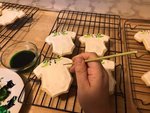


As you prepare to bake your favorite Christmas cookies this holiday season, know that you are partaking in a centuries-old tradition with origins that go as far back as the European Middle Ages. From kings and queens to the village cobbler, Christmas cookies were made and enjoyed by all who observed the Christmas holiday.
The cookie itself dates back some 10,000 years, according to the website, Christmascarnivals.com, when farmers would mix grains and water to create a paste that they would then bake on hot stones. Tasty? Probably not, but historians speculate that it was a practical food source at a time when refrigeration was not an option.
The cookie began to take more form with the introduction of widespread trade between the East and West, which brought back never-before-seen-or-used spices such as cinnamon, nutmeg, black pepper, and cardamom, as well as dried fruits and dates.
However, these ingredients weren’t readily available to the masses, much less affordable. Moreover, in the Middle Ages, baking was a craft performed by special guilds, but for the occasion of Christmas, folks from all walks of life were allowed to splurge on these extravagant ingredients to bake sweet treats that could be shared and given as gifts to family, friends and neighbors.
As time went on, different recipes became popular in different regions. In Germany, Lebkuchen was the Christmas cookie of choice, and was invented by German monks. First documented in 1296, the cookie’s roots go back to the Egyptians, Greeks and Romans, who used honey as a natural sweetener in their baked goods.
By 1395, these cookies were being baked in Nuremberg, which today, is still the capital for this holiday favorite. Lebkuchen come in a variety of shapes, sizes and flavors, but almost always include honey, nutmeg, aniseed, cardamom, coriander, ginger, allspice, and nuts or dried fruit.
To the north, in Norway, the popular cookie was krumkake, a descendent of the Italian pizzelle. The batter was made from flour, butter, eggs and cream, and was baked in a decorative iron over heat.
According to historians, gingerbread was the first cookie to be associated with Christmas. In England, Queen Elizabeth I had gingerbread molded into the shapes of her favorite courtiers, from which the treasured holiday favorite—gingerbread men—were born. But it wasn’t until hundreds of years later in the 19th century that gingerbread would become synonymous with the Christmas holiday, thanks to Queen Victoria and Prince Albert, who made it a part of their Christmas celebration.
Many of the Christmas traditions we observe today come from Germany, such as the decorated Christmas tree. Ornaments included cookies that were cut into festive shapes, using a cutter, often made of metal or copper. By the late 1800s, cookie cutters were being mass produced and exported all over the world, and recipes for Christmas cookies were finding their way into cookbooks everywhere.
So how did the beloved Christmas cookie make its way to America? We have the Dutch to thank for that, who brought the Christmas Koeptje (meaning small cake) to America in the 17th century.
However, not everyone was making Christmas cookies in colonial times. In the Puritan era in New England, for example, Christmas celebrations were outlawed from 1659 to 1681, and punishable by high fines if one was caught making merry.
But in other colonies, like the Dutch-found New Amsterdam (present-day New York), cookies were a part of both the Christmas and New Year’s holidays.
The Christmas cookie tradition continued to spread in America, and in 1796, the first recipe was printed in Amelia Simmons’s cookbook, “American Cookery,” titled “Another Christmas Cookey.” Ingredients included coriander, butter, sugar and milk. Once baked, the cookies were to be stored in an “earthen vessel in a dry cellar or damp room” and recommended to be consumed six months later!
The Christmas cookie has certainly evolved over time, and grown into a multi-billion-dollar industry worldwide. Locally, Center Moriches’ very own Nettie’s Country Bakery will be baking thousands of pounds of cookies during the holiday season, said baker and owner, Joe McHeffey.
“The bakery is a holiday business, so we are busy on all holidays, but the Christmas season is the busiest and cookies are the most popular,” noted McHeffey.
At Nettie’s, a variety of Christmas cookies will be baked onsite and then assembled and sold at the bakery, offsite at other retail locations, and shipped all over the country, even as far as Hawaii, said McHeffey. A typical cookie assortment will feature chocolate chip cookies, biscotti, coconut macaroons, lemon and tea cookies, rainbow cookies, Christmas sugar cookies, butter cookies, gingerbread cookies and coconut/chocolate chip bar cookies.
McHeffey said the recipes come from a variety of sources, from family favorites to recipes shared from friends. Nettie’s tea cookies and coconut chocolate chip bars are courtesy of McHeffey’s Aunt Anne, while the biscotti and butter cookies come from his brother-in-law George. As for the ever-popular Christmas sugar cookie recipe, McHeffey learned that many years ago when he was an apprentice at Pierre’s Bakery, which was located on Main Street in Center Moriches.
Some may argue that one of the most beloved Christmas cookie traditions is baking and leaving cookies for Santa Claus on Christmas Eve. This exercise is said to have started in the 1920s and ‘30s by parents who used it as a way of teaching their children to be grateful, while other historians muse that it was started by naughty children who were trying to bribe Santa Claus to leave gifts, despite their bad behavior.
Another treasured tradition is giving cookies as gifts during the holiday season. Center Moriches resident Corinne Flynn-Bernath has been baking and elaborately decorating cookies to give to family and friends for 23 years.
It started at a time when she and her husband, both native New Yorkers, were living in San Francisco. With a new baby and a meager budget, the Bernaths didn’t know how they were going to purchase Christmas gifts for their loved ones back North that Christmas. While waiting on line at a supermarket, Bernath noticed a Martha Stewart magazine that touted the idea of giving cookies as gifts. From that Christmas on, Bernath said she has baked thousands of sugar cookies with icing, for Christmas and just about every other occasion.
“I have made every shape and color you can think… it’s my little Christmas miracle,” she added.
The Christmas cookie swap made its way on the scene in the early 20th century, becoming significantly more popular in the 1960s. A cookie swap is when a group of friends get together to exchange their favorite Christmas cookies, along with the accompanying recipe.
Here, in Center Moriches, resident Michelle Mitchell is busy preparing for her 17th annual Cookie Swap, an extravaganza that involves dozens of bakers whipping up their best cookie recipes. Each year, Mitchell plans a flurry of games and activities, in addition to the swap itself.
This year, she said she’s “dialing it back a notch” in an effort to keep it more of a traditional swap.
“The theme is KISS: Keep it Simple Swappers! My hope this year is to have an afternoon filled with good food, conversation, laughter and of course, cookies,” said Mitchell.
Comments
No comments on this item Please log in to comment by clicking here